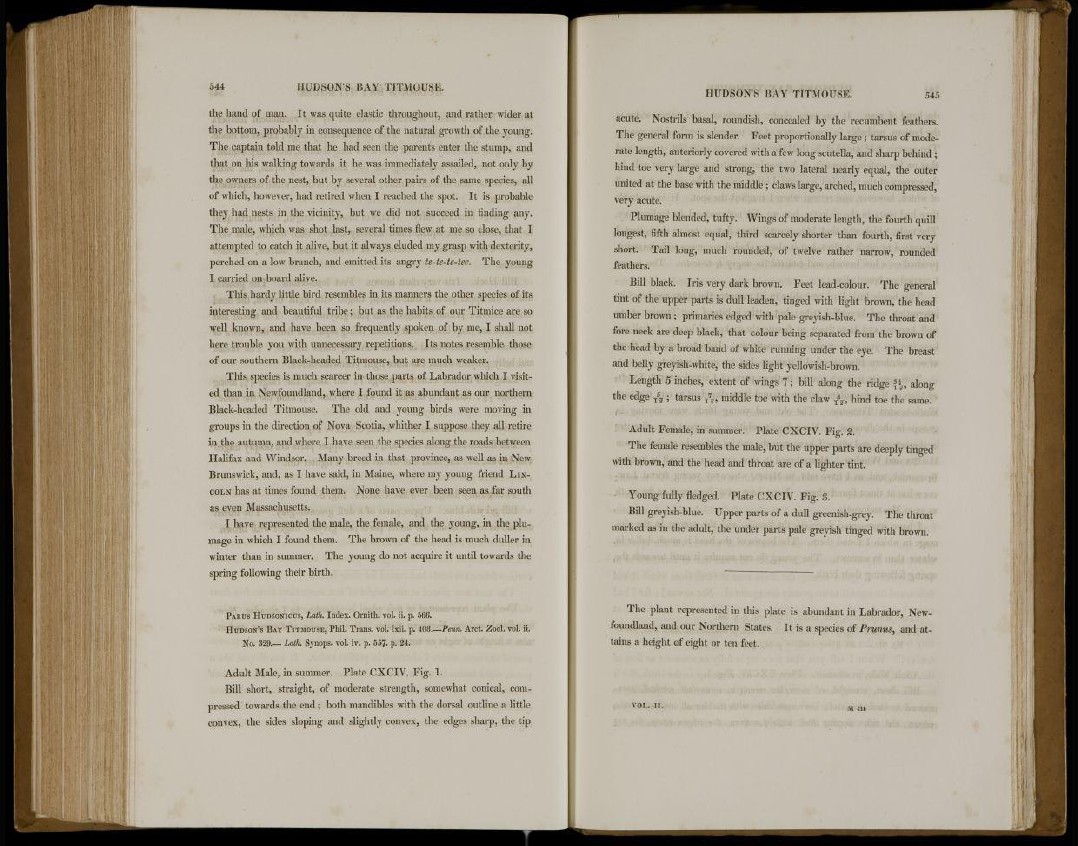
acute. Nostrils basal, roundish, concealed by the recumbent feathers.
The general form is slender. Feet proportionally large; tarsus of moderate
length, anteriorly covered with a few long scutella, and sharp behind ;
hind toe very large and strong, the two lateral nearly equal, the outer
united at the base with the middle ; claws large, arched, much compressed,
very acute.
Plumage blended, tufty. Wings of moderate length, the fourth quill
longest, fifth almost equal, third scarcely shorter than fourth, first very
short. Tail long, much rounded, of twelve rather narrow, rounded
feathers.
Bill black. Iris very dark brown. Feet lead-colour. The general
tint of the upper parts is dull leaden, tinged with light brown, the head
umber brown ; primaries edged with pale greyish-blue. The throat and
fore neck are deep black, that colour being separated from the brown of
the head by a broad band of white running under the eye. The breast
and belly greyish-white, the sides light yellowish-brown.
Length 5 inches, extent of wings 7; bill along the ridge along
the edge T
5
2 ; tarsus {'^ middle toe with the claw T
6
g , hind toe the same.
Adult Female, in summer. Plate CXCIV. Fig. %
The female resembles the male, but the upper parts are deeply tinged
with brown, and the head and throat are of a lighter tint.
Young fully fledged. Plate CXCIV. Fig. 3 .
Bill greyish-blue. Upper parts of a dull greenish-grey. The throat
marked as in the adult, the under parts pale greyish tinged with brown.
The plant represented in this plate is abundant in Labrador, Newfoundland,
and our Northern States. It is a species of Prunus, and attains
a height of eight or ten feet.
VOL. II. vi m
the hand of man. It was quite elastic throughout, and rather wider at
the bottom, probably in consequence of the natural growth of the young.
The captain told me that he had seen the parents enter the stump, and
that on his walking towards it he was immediately assailed, not only by
the owners of the nest, but by several other pairs of the same species, all
of which, however, had retired when I reached the spot. It is probable
they had nests in the vicinity, but we did not succeed in finding any.
The male, which was shot last, several times flew at me so close, that I
attempted to catch it alive, but it always eluded my grasp with dexterity,
perched on a low branch, and emitted its angry te-te-te-tee. The young
I carried on board alive.
This hardy little bird resembles in its manners the other species of its
interesting and beautiful tribe; but as the habits of our Titmice are so
well known, and have been so frequently spoken of by me, I shall not
here trouble you with unnecessary repetitions. Its notes resemble those
of our southern Black-headed Titmouse, but are much weaker.
This species is much scarcer in those parts of Labrador which I visited
than in Newfoundland, where I found it as abundant as our northern
Black-headed Titmouse. The old and young birds were moving in
groups in the direction of Nova Scotia, whither I suppose they all retire
in the autumn, and where I have seen the species along the roads between
Halifax and Windsor. Many breed in that province, as well as in New
Brunswick, and, as I have said, in Maine, where my young friend LINCOLN
has at times found them. None have ever been seen as far south
as even Massachusetts.
I have represented the male, the female, and the young, in the plumage
in which I found them. The brown of the head is much duller in
winter than in summer. The young do not acquire it until towards the
spring following their birth.
PARUS HUDSONICUS, Lath. Index. Ornith. vol. ii. p. 566.
HUDSON'S BAY TITMOUSE, Phil. Trans, vol. lxii. p. 408—Penn. Arct. Zool. vol. ii.
No. 329 Lath. Synops. vol. iv. p. 557. p. 24.
Adult Male, in summer. Plate CXCIV. Fig. 1.
Bill short, straight, of moderate strength, somewhat conical, compressed
towards the end; both mandibles with the dorsal outline a little
convex, the sides sloping and slightly convex, the edges sharp, the tip